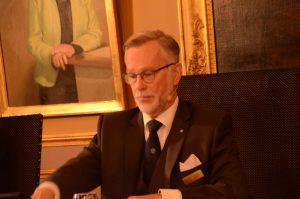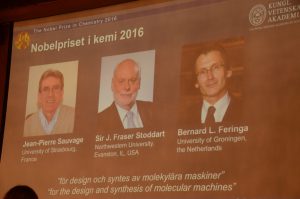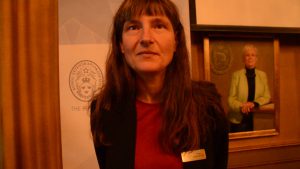By Xuefei Chen Axelsson
STOCKHOLM, Oct. 5(Greenpost)–Nobel Laureate Fraser Stoddart said that’s what driven him through chemistry, its wonderful ability to express yourself in an artisitic form.
J. Fraser Stoddart’s wife died twelve years ago so he first shared the news with his two daughters.
He said he was shocked and his students were overwhelmed. He felt glad that Sauvage and Feringa won the prize together with him.
Feringa said he will use the money for further research because it was the cooperation of many researchers.
BF: Ja, of course. If you look at the cells in our body or the functioning of the organism, it is flabbergasting. It is fantastic to see how this intricate machinery works. And when I’m taking about motors, as we focus on motors, if you look at the essential functions in the cell, like cell division, like transport, like making your muscles move, bacteria that go to food or [unclear …] it’s all controlled by molecular motors, and so the biological motors, and the biological machinery, is so crucial to all these functions. And of course we get great inspiration from that, while we as chemists are extremely good in building all kinds of materials, and that is what intrigued me. And there is where we look at mother nature, but of course we have to build it more or less from scratch because many of the systems that mother nature uses we cannot use in our nanomachinery, because they are soft materials that are not very stable that only function properly in the complex cell environment etc. So that is the reason that we build these machines. And compare it to a flying machine. We don’t build a Boeing after a pigeon. A pigeon flies perfectly, the bird flies, ja, but the Boeing is not the same materials, it has not the same flying principle, but it works perfectly to transport 3-400 people across the ocean.
AS: That’s perfect. And people often make the comparison with Lego. They say you’re building with the tiniest Lego.
BF: Absolutely. So we use molecules as a kind of Lego kit, ja. And so we have access to this unlimited number of molecules and we use them to build the new materials, the drugs of the future, and in this case also the nanomachinery and the smart materials of the future. And yes, I feel often, and me and my students and the team, and I’m sure that it’s the same for the other teams of Stoddart and Sauvage, we feel sometimes like kids playing with these molecules and seeing what are the possibilities to build, like with Lego. As a kid you had fun to build new kinds of castles, and that is actually what we are doing. And then hopefully, and this is our main goal of course, to build in all kinds of new functions. And in this case the function of transport, motion, machinery.
AS: That’s a fantastic, inspirational message for the next generation of scientists. Just go out there and express yourself and have fun.
Source, Nobel website.




